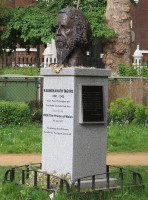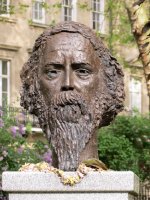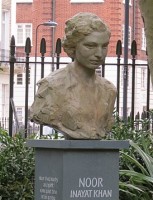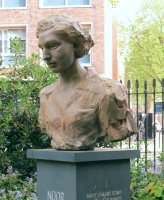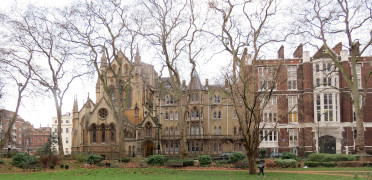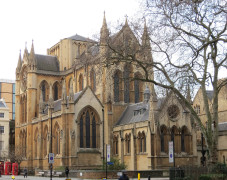Sculpture in Gordon Square, London
This London square, south east from Euston Station and not far from the British Museum, was developed by the builder Thomas Cubitt as one part of a pair with nearby Tavistock Square, which is of the same size. Much of the Square is still occupied by ranges of rather plain, yellow London brick teraces, of four and five stories, with the tallest group having balconies and a decorated cornice to add to the otherwise rather minimalist Classical detail. No Victorian sculpture here, unfortunately, but a restoration of the central gardens by the University of London has seen the installation of two modern busts, admittedly somewhat off topic for these pages.
Rabindranath Tagore, modern, by Shenda Amery.
The slightly earlier piece is a head of Rabindranath Tagore, unveiled 2011, installed by the Tagore Centre UK. It is solely the head, resting on a circular column rather than any attempt at a neck, with the thick beard and hair avoiding awkwardness in the view from the front. Highly worked bronze, left with a textured finish - click the picture to enlarge to see properly. The sculptor was Shenda Amery; a public work by her of some years ago is the Ambrika fountain in London Zoo.
Noor Inayat Khan, modern, by Karen Newman.
The second sculpture in the Square is the bust of Noor Inayat Khan which has a carefully modelled face and neck, with unfinished hair and upper torso. We see a young woman – she was just 31 when she perished in a concentration camp – and she is posed with neck slightly forward and head tilted slightly downward, suggesting a purposeful but contemplative nature, which seems fitting for a member of the Special Operations Executive. The work was emplaced in 2012, and is the work of the sculptor Karen Newman, who worked for many years for Madame Tussauds, but is represented by at least one other portrait sculpture in London, of Violette Szabo, another SOE spy, by Lambeth Palace.
Two views of the Catholic Apostolic Church, by J. R. Brandon, 1850s.
Adjacent to the southern end of the Square on the western side is the rather large Catholic Apostolic Church, which is not open to the public. The full length cannot be observed – the nave extends back behind other buildings – and from the side, we can see that there was intended to be a tower, which was never built. However the irregular Victorian Gothic contour of the honey-coloured Bath stone front forms a pleasing backdrop to the Square. It was put up in the early 1850s and the architect was John Raphael Brandon, better known for his writings than his extant buildings.
